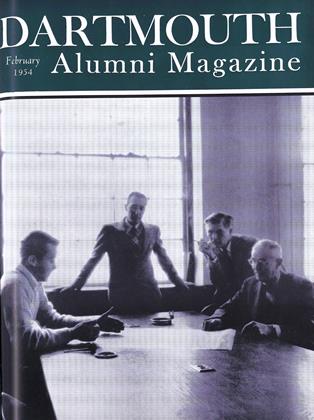SHIPS AND SUGAR: AN EVALUATION OF PUERTO RICAN OFFSHORE SHIPPING.
February 1954 MARTIN L. LINDAHLBy Samuel Ewer Eastman andDaniel Marx Jr. '29. Rio Piedras: Universityof Puerto Rico Press, 1953. 239 pp.
Economists have long recognized the crucial importance of transportation in a world economy where higher living standards may be attained from geographical specialization in the productive process. The mutual interdependence of nations and regions is strikingly illustrated in the island economy of Puerto Rico. Specializing in the production of sugar and to a modest extent in the manufacture of textiles and other consumer products, Puerto Rico is able to export these commodities largely to the mainland of the United States and to receive in exchange some 60 per cent of the basic foods required to feed its 2,200,000 people. The vital significance of ocean and air transportation in these circumstances is apparent, and any improvement in the efficiency of transport operations can contribute to the welfare of a people who are said to be by far the poorest citizens of the United States.
Ships and Sugar is the final report of a study of Puerto Rican offshore shipping which was directed by Professor Marx. With the aid of numerous statistical tables, graphs, and photographs, the authors make a careful and highly competent analysis and evaluation of air passenger service, port and terminal operations, and the services, and rates of cargo carriers. They also treat the impact of ocean freight rates and services upon the cost of living and the industrialization program.
The Island is found to enjoy excellent shipping service rendered largely by the domestic conference carriers, which are protected from foreign-flag competition by the general restriction excluding foreign ships from all American coastwise shipping. And the handling of cargo by the conference lines at the three major Puerto Rican ports compares favorably with operations in other Caribbean areas. But certain conditions are noted which increase costs and therefore contribute to higher selling prices of imported products. Among these are congestion in the streets and at the terminals and wasteful practices such as partial delivery and multiple markings of single commodity shipments. Costs of handling outbound traffic are also found to be adversely affected by the highly uneven movement of sugar, which irregularity stems from seasonal variation in both harvesting and consumption and to speculation in the sugar market.
Owing to the mixture of competitive and monopolistic elements in the market structure, the authors are particularly concerned about the level and the structure of ocean freight rates. Since four carriers dominate the trade between the Island and the mainland and since they tend to specialize as regards traffic and do not serve the same mainland ports, a considerable element of monopoly is introduced. This is accentuated by the existence of shipping conferences or rings, which agree on rates and practices in an effort to avoid the ruinous competition which is apt to occur in the chronically over-tonnaged shipping business. Both actual and potential competition afford some protection to shippers from excessive rates and discriminatory practices. But greatest reliance must be placed on the regulatory authority of the Federal Maritime Board.
It is recommended that a full-scale investigation of shipping costs be undertaken in order to determine the appropriateness of the current rate level and the remunerativeness of the very favorable rates on sugar. The possibility of removing the coasting restrictions and allowing lower-cost foreign shipping to enter the field is an alternative in the event of the failure of regulation, but the advocacy of such a policy runs the risk of the exclusion of Puerto Rico from the United States customs area.
This book will appeal primarily to students of transportation. Anyone interested in the economic problems which confront an underdeveloped area, however, will find much of value in this concise and well-written account.
 View Full Issue
View Full Issue
More From This Issue
-
 Feature
FeatureDartmouth's Faculty Policies
February 1954 By DONALD H. MORRISON '47h -
 Feature
FeatureTestament of a Teacher
February 1954 By ROYAL CASE NEMIAH '23h -
 Feature
FeatureThe Teacher of Social Science and the World Crisis
February 1954 By JOHN CLINTON ADAMS -
 Feature
FeatureMy "Most Unforgettable Character"
February 1954 By JAMES L. MONTAGUE '28 -
 Class Notes
Class Notes1918
February 1954 By ERNEST H. EARLY, W. CURTIS GLOVER, RICHARD P. WHITE -
 Class Notes
Class Notes1932
February 1954 By JOHN A. WRIGHT, JOHN B. WOLFF JR.
MARTIN L. LINDAHL
Books
-
 Books
BooksMovable Bridges: vol 1 Superstructure
August, 1926 -
 Books
BooksCONNECTICUT RIVER
June 1939 -
 Books
BooksNotes on medieval beasts and the versatile writer who modernizes them, and memorials for a Dartmouth organist.
March 1977 -
 Books
Books"Eight O'Clock Chapel"
MARCH, 1928 By A. W. Vernon -
 Books
BooksTHE PSYCHOLOGY OF SUCCESSFUL SELLING
July 1953 By C. L. STONE '17 -
 Books
BooksNOTHING BUT LIGHT.
MAY 1973 By DAVID BOWMAN '63


